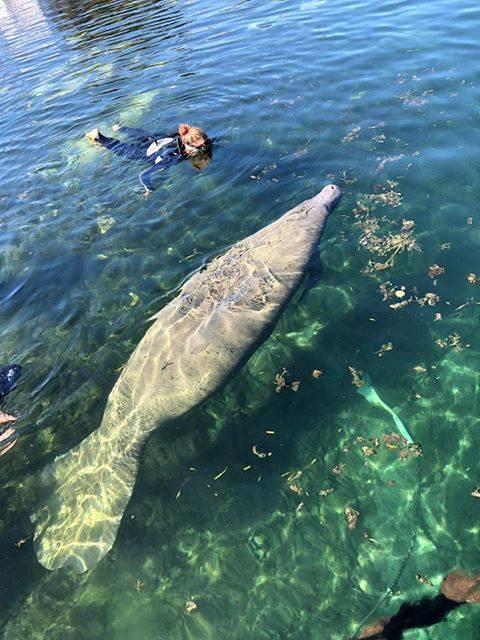Breath of the Springs: A Private Swim with Crystal River’s Manatees
Four hours, warm springs, and gentle giants—plus a private boat, hot cocoa, and local insight.
The morning light drifts across Kings Bay like a slow-breathing tide, and the water answers in a whisper—liquid glass at 72 degrees, steady as a metronome. Your captain cuts the motor and the bay hushes in return. A ring of bubbles rises beside the boat, then a whiskered muzzle breaks the surface, exhales, and vanishes with a push that feels more ancient river than animal. On a private boat with a small group of friends or family, the scene shrinks to the simple rhythm of the springs and the unmistakable presence of manatees—curious, unhurried, and larger than you imagined.
Trail Wisdom
Master Passive Observation
Float horizontal, keep fins still, and let manatees approach. Avoid chasing or cornering—your calm presence leads to better encounters.
Beat the Crowds
Book an early start for the clearest water and the most relaxed manatee behavior, especially in winter months.
Defog Your Mask Right
Use a small drop of baby shampoo or dedicated defog and rinse gently. Spit works in a pinch, but avoid oils or lotions.
Stay Warm Between Swims
Bring a towel and a cozy layer or beanie for the boat. Even at 72°F, repeated dips can chill you on breezy mornings.
Local Knowledge
Hidden Gems
- •Three Sisters Springs boardwalk for a top-down view of spring vents
- •Hunter Springs Park for an easy post-tour stroll and a chance to spot mullet schools
Wildlife
West Indian manatee, Osprey
Conservation Note
Honor sanctuary markers and practice passive observation. Avoid lotions before entering the water and keep fin kicks minimal to preserve clarity and reduce stress on wildlife.
Crystal River National Wildlife Refuge was established in 1983 specifically to protect the West Indian manatee and its critical winter habitat.
Seasonal Guide
spring
Best for: Clear post-front days, Smaller crowds
Challenges: Variable manatee numbers, Occasional pollen on surface
Shoulder season with lingering cool mornings and occasional crystal-clear water after fronts. A good balance of encounters and space.
summer
Best for: Warm air temps, Leisurely boating
Challenges: Fewer manatees overall, Afternoon thunderstorms and boat traffic
Resident manatees remain, especially early mornings. Plan around storms and aim for the first boat out.
fall
Best for: First manatee returns, Pleasant air temps
Challenges: Hurricane season can disrupt plans, Water clarity can fluctuate
As Gulf waters cool, manatees begin migrating back into the bay. Flexible schedules pay off with uncrowded days.
winter
Best for: Highest manatee concentrations, Cold, clear mornings
Challenges: Chilly boat rides, More visitor activity
Prime season. Dress warm for the ride, then let the wetsuit handle the spring-fed water while the manatees fill the scene.
Photographer's Notes
What to Bring
Rash Guard or Swim ShirtEssential
Provides sun protection and warmth without relying on lotions that can affect water quality.
Dry Bag (10–15L)
Keeps phones, a warm layer, and a towel dry on the boat between swims.
Reusable Water BottleEssential
Hydrate between swims and reduce single-use plastics on the water.
Action Camera with Anti-Fog Inserts
Captures steady underwater footage while preventing lens fog in cool spring water.
Common Questions
When is the best time to see the most manatees?
Winter, especially January and February, when Gulf waters cool and hundreds of manatees gather in Kings Bay’s warm springs.
Do I need to be a strong swimmer?
No. The tour provides noodles and a patient briefing. Basic comfort floating and breathing through a snorkel is sufficient.
Can I touch the manatees?
No. Passive observation is required by federal guidelines—no touching, chasing, or separating mothers and calves.
Is gear included?
Yes. Wetsuits, masks, snorkels, and noodles are provided, along with bottled water and light snacks.
How cold is the water?
Kings Bay’s spring water is about 72°F year-round. A wetsuit keeps you comfortable, but bring warm layers for the boat in winter.
Will the tour run in rain?
Yes, light rain is fine and can calm the surface. Thunderstorms or unsafe conditions may delay or reschedule for safety.
What to Pack
Warm boat layer (hoodie or beanie) for between swims; Towel for quick warm-ups; Reusable water bottle to stay hydrated; Waterproof phone case or dry bag for valuables on the boat
Did You Know
Crystal River National Wildlife Refuge is the only U.S. wildlife refuge established specifically to protect the West Indian manatee and its habitat.
Quick Travel Tips
Arrive 30 minutes early for the mandatory briefing; Plan for early morning for best clarity and calmer bays; Avoid sunscreen before entering—use a rash guard instead; Build in extra time to visit the Three Sisters Springs boardwalk after your tour
Local Flavor
Post-springs, refuel at Seafood Seller & Cafe for Gulf-fresh catches or sip a small-batch brew at Copp Brewery & Winery. For a quick caffeine stop before your tour, Cattle Dog Coffee Roasters is a local staple. If you’re exploring farther south, The Freezer Tiki Bar in nearby Homosassa serves no-frills, fresh shrimp right off the boats.
Logistics Snapshot
Closest airports: Tampa (TPA) ~1.5–2 hours, Orlando (MCO) ~2 hours, Gainesville (GNV) ~1.5 hours. Launch area: Kings Bay, Crystal River. Drive time from downtown Crystal River: 5–10 minutes. Cell service: Generally good in town; variable on the water. Permits: No personal permit needed, but a pre-tour manatee briefing and adherence to USFWS sanctuary rules are mandatory.
Sustainability Note
You’re entering a federally protected refuge. Skip lotions, keep your distance, and move slowly to avoid stirring silt. Pack out all trash, secure loose items on deck, and let manatees set the terms of the encounter.
